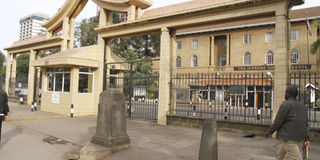MPs decry waste in court projects

The entrance at gate at the Supreme Court of Kenya in Nairobi. PHOTO | JEFF ANGOTE
What you need to know:
- “We’re all trying to remove the aspect of wastage,” he said. “Kenyans are concerned about Chinese gates and the amount of money that goes into those structures. What’s the significance?” Mr Anami asked.
When the Judiciary was recently put on the spot over the high cost of its construction projects, Parliament used it as an example to point to massive waste in government that has to be checked.
Chief Registrar Anne Atieno Amadi, her deputy Kakai Kissinger and their team of technocrats were hard-pressed to explain what appears to be massive waste and cost discrepancies at a meeting with the Budget and Appropriations Committee.
Mr Kissinger revealed that in this financial year, the Judiciary is putting up a courthouse on a five-acre piece of land in Lodwar at a cost of Sh800 million and another one on a two-acre parcel in Bomet for Sh600 million.
Asked about the difference, Mr Kissinger explained the costs in Lodwar are higher than in Bomet because labour has to be sourced from outside the area, and transport is expensive.
As a point of comparison, the cost to build the two courthouses seems very high, given that it cost the government Sh700 million to buy the former Shell/BP building on Harambee Avenue in Nairobi’s Central Business District and convert it into the Office of the Prime Minister. The building currently houses the Deputy President.
“If you’re going to put up courts all over the country at that cost, then we have a problem in the Judiciary,” Kipipiri MP Samuel Gichigi (APK) said.
Committee chairman Rev Mutava Musyimi spoke of a recent visit and chat he had with Kenyatta University vice chancellor Prof Olive Mugenda, who has overseen massive improvement of infrastructure at the institution.
The work at the main campus includes the construction of facilities like the Post-Modern Library, the Chandaria Business Incubation Centre and other buildings that house the computer and students’ centres and the arts faculty.
“The vice chancellor was kind enough to tell us she was having a lot of problems with contractors, and she had to get to the point where she engaged her own contractors. She got her own architects, her own engineers — everybody,” he said.
Rev Musyimi added that “serious buildings” have been going up at the main campus at Kenyatta University.
“The question is, why can’t the Judiciary if it has this huge programme of construction, get its own contractors, quantity surveyors, engineers and architects?” Rev Musyimi said.
Elaborate entrance gate
And there were more shocking revelations when Shinyalu MP Silverse Anami claimed the elaborate entrance gate at the Supreme Court was imported from China at a very high cost. He claimed the mponey spent “can account for the construction of more than 10 primary schools”, but he likely meant 10 classrooms.
“We’re all trying to remove the aspect of wastage,” he said. “Kenyans are concerned about Chinese gates and the amount of money that goes into those structures. What’s the significance?” Mr Anami asked.
His concern, like that of his colleagues who will spend the next few months balancing the Budget and deciding to whom to give and from whom to take away, was the wastage they have unearthed in government.
Mr Kissinger admitted the brick and mortar structure at the Supreme Court building was a Chinese design.
“I think it was the creativity of the Ministry of Public Works when they were doing it,” said Mr Kissinger. He heads the team at the Judiciary that is overseeing construction of more courtrooms across the country. The aim is to have a High Court in every county, the Court of Appeal further decentralised from Nairobi and old court houses refurbished.
So important is the issue that Mr Kissinger begged the committee not to reduce the allocations to development expenditure.
The agenda of the meeting with the Budget team was the presentation of the Judiciary’s views on the Budget Policy Statement. The Judiciary said it needed Sh26.2 billion for the next financial year. The Budget team has recommended a maximum Sh17 billion —Sh12 billion for recurrent expenditure and Sh4.9 billion for development.
But the Judiciary says it needs at least Sh13 billion for recurrent expenditure. According to Prof Margaret Kobia, who sits in the Judicial Service Commission, the problem in the cost of building courtrooms lies in procurement.
She said from her experience at the Kenya School of Government, they borrowed ideas from the Kenyatta University approach. Ms Amadi said the Judiciary is setting up a building unit that will oversee all infrastructure projects.





